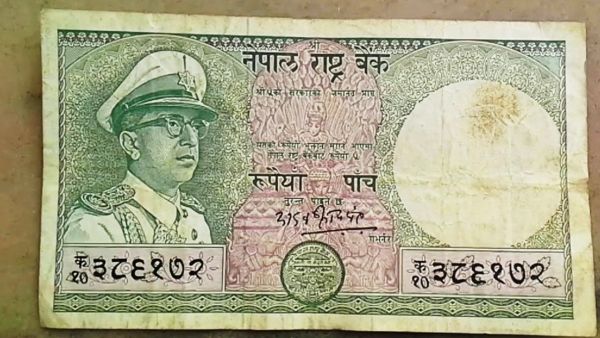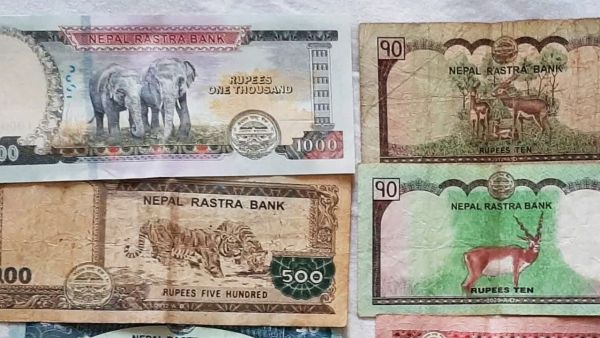

The economy is being affected by the deteriorating situation of Nepal's currency, the protesters have also made it an issue.
India's neighboring country Nepal has come into the limelight due to protests from youth. After the ban of social media forums Facebook, Instagram etc., people are demonstrating in the country 18 to 28 years. In this, 21 people have lost their lives and more than 400 are injured. The army has to be deployed in many places. Meanwhile, Nepal's Home Minister Ramesh writer has resigned. It is said that the deteriorating economic situation and corruption are also one of the reasons for this demonstration. The economy is being affected by the deteriorating situation of Nepal's currency.
This is the same currency on which the pictures of the kings of Nepal were printed. After the end of the monarchy, the pictures on currency changed. Let us know who printed on Nepal's currency? What is their history and their importance in the country?
Pictures of kings printed from 1945 to 2007
In Nepal too, earlier gold and silver coins used to run, which were called seals and Ashrafi. Mugah was actually a coin of 50 paise, on which Guru Gorakhnath's name and Paduka were engraved. Nepali rupee started in the year 1932. For the first time in 1945, five, 10 and hundred rupees paper notes were issued in Nepal, which were called Moharru in Nepali. These notes were issued by the then king Tribhuvan and his picture was also printed on them.
These notes were printed in India Security Press in Nashik, India. There was no special security feature in these notes. They were just printed on special paper and they used to have water mark.
From 1945 to 1955, these notes were issued by the royal treasury, because there was no central bank in Nepal. The right to issue these notes was with the treasury, which is known as Sadar Muluki Khana. These notes were not signed by any governor, but they were issued with the signature of the cashier. This treasurer was also the highest Hindu priests of the country at that time.

The picture of King Tribhuvan, which is printed on the currency of Nepal, is called the Father of the Nation.
After the establishment of Nepal's Central Bank in 1956, the right to print the notes went to him. In 1945, the tradition of publishing the image of the king on notes continued till 2007, until new notes were issued in Nepal after the end of the monarchy. In this era, pictures of a total of four kings were published on Nepal's notes.
Rana family was holding Nepal
King Tribhuvan Veer Vikram Shah of Nepal was born on 30 June 1906. His father was King Prithvi Veer Vikram Shah. Due to his father's death, he was seated on the throne at the age of only five and mother Divyeshwari Lakshmi Devi was appointed as his guardian till he became an adult. However, at that time the monarchy in Nepal was only nominal and the real power was with the Rana family, the family from which the Prime Minister of Nepal was made. Apart from this, there was also a cabinet. King Tribhuvan was called to the Singh Durbar every Thursday, where he had to wait for the Prime Minister for hours.

King Prithvi Veer Vikram Shah.
Stress increased during the First World War
During the First World War, tension increased between the royal family and the Rana family, as the Rana family wanted to send Nepal's army into a fight with Britain, while the royal family wanted to remain neutral in this war. Finally, the then Prime Minister Chandra Shamsher Jung Bahadur pushed the Nepal's army into the war by pressuring and threatening his mother. After this, tension in both the families kept increasing.
With the help of India, Nepal got rid of Rana family
At that time, the Praja Parishad in Nepal was struggling to end the domination of the Rana family and King Tribhuvan was very close to him. Therefore, in the year 1950, the king had to take refuge with his family in the Indian Embassy in Nepal. He was accompanied by son Mahendra and elder grandson Virendra. After this, the then Prime Minister of Nepal, Mohan Shamsher Jung Bahadur Rana, called an emergency meeting and declared Gyanendra Veer Vikram Shah, the four -year -old grandson of King Tribhuvan, as the king of the country. At the same time, the then Prime Minister Pandit Jawaharlal Nehru sent two planes to call King Tribhuvan and his family to India.
Due to this, the Rana family came under pressure and over time his opposition in Nepal increased. Finally, in the year 1951, King Tribhuvan returned to Nepal and after some time and after being in office, the dominance of the Rana family from Nepal ended. After this, King Tribhuvan created modern Nepal. However, at the age of only 49, he died on 9 March 1955 in Zurik, Switzerland.

King Mahendra.
Nepal caught progress during King Mahendra's time
After King Tribhuvan Veer Vikram Shah, his elder son Mahendra became king in the year 1955 and ruled before the death in 1972. The year 19601970 was printed on the Nepali notes of him. Raja Mahendra started the panchayat system which continued further. This system ended after the start of multi -party democracy in 1990. During the time of King Mahendra, Nepal saw industrial, political and economic change and progress. The doors of Nepal opened to the world and it moved forward on the path of development.
After his death, Virendra Vikram Shah Dev became the king of Nepal, who was killed in 2001 in the famous massacre of the royal family of Nepal. After killing the Raj family in the firing, Dipendra Veer Vikram Shah was made the king but he shot himself and was in a coma. He died after being in a coma for three days. Most notes between 1970 and 1990 printed a picture of King Virendra. King Gyanendra, the last king of the monarchy of Nepal, whose picture appeared on the notes of the last round of the monarchy and this series ended in 2007.

After 2007, the photo of kings was removed from Currency and the photos of Mount Everest and animals were installed.
Now their pictures are seen on Nepali notes
In 2007, Nepal became a republic and pictures of kings were removed from Nepali notes. In his place, a picture of Sagaramatha (Mount Everest) started appearing on 500 and 1000 Nepali Nepal notes. Five and 10 notes, Yak on the note of 50, musk deer, a horny rhino on the Nepali note of a hundred, five hundred as well as the picture of Nepal's national bird Himalayan Monal (Damph Bird), as well as photographs of Nepal's national flower Rhododendrone, Paddy Cultivation, Temple and Smarak etc.
Pictures of many areas including Lord Indra, wood carving are also seen on Nepali notes. Even Nepal, describing many areas of India as its own, started printing their pictures on their notes, on which India also expressed strong opposition.
-
Hina Khan Blasts Farrhana Bhatt Over Ashnoor Kaur Remark In Bigg Boss 19: 'Don’t Dare...'

-
Mercedes To Audi: GST Reforms Make Luxury Cars Cheaper For Indian Buyers

-
Dharmasthala Case: Three Kerala YouTubers Among Six Questioned By SIT

-
'Playing XI Message Kar Deta Hoon': Suryakumar Yadav Gives Hilarious Response To Reporter On Question About Sanju Samson Ahead Of Asia Cup Opener; Video

-
New Delhi: University College Of Medical Sciences Receives Bomb Threat; Premises Declared Safe After Thorough Check
